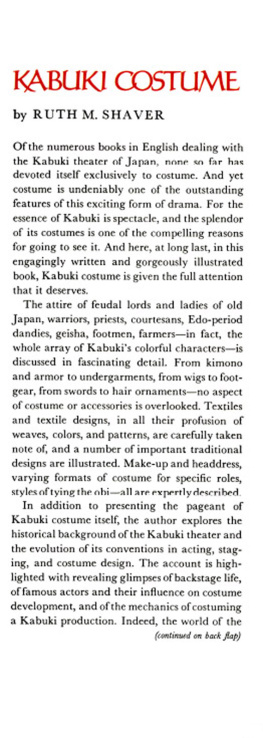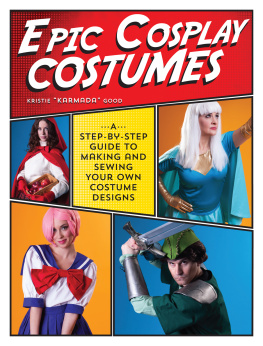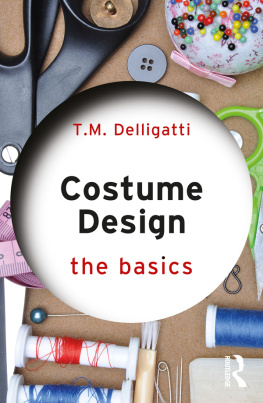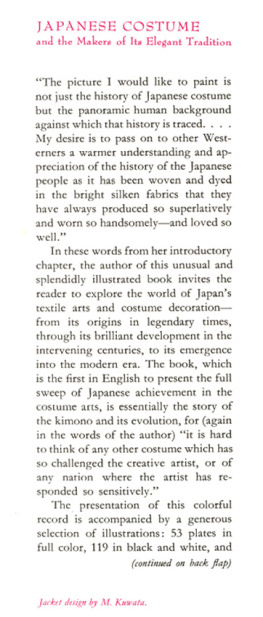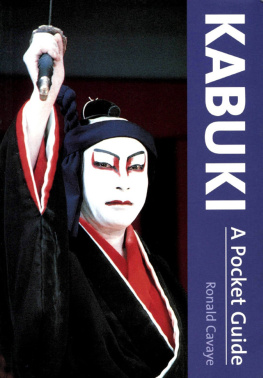I owe much to the many invaluable friends I have made in the Kabuki theater over a span of some thirteen years. During this time I attended Kabuki performances on an average of six times a month, or a total close to one thousand performances. Among my Kabuki friends, I owe special thanks to Onoe Baik VII, Onoe Kikuz VI, Onoe Taganoj III, Ichimura Uzaemon XVII, and Sawamura Tanosuke VI, not only for their special friendship, but for their patient and thoughtful instructions regarding the intricate history and background of their special roles and the costumes that have been worn by them and their predecessors.
I also owe a special debt of gratitude to my teachers, whom I commissioned during a number of years to give me a series of personal lectures from Japanese documentary and other sources to supplement my academic knowledge of Kabuki.
Mr. Akira Sma, painter, scholar, authority on Kabuki costumes, and son of the noted poet Gyof Sma, was an inspiring teacher and a perceptive artist who sketched and painted the majority of the detailed illustrations in this book.
Mr. Gak ta, artist and adviser to the Meiji-za (theater) in Tokyo, instructed me on all forms of Japanese theater arts covering the past thirteen hundred years or more. He was the source of the information given in the chapter on kumadori, a subject to which he has devoted more than thirty years of study. The illustrations for kumadori are his, as well as some of those for costumes.
Mr. Yasuji Toita, a leading Kabuki critic and author, fascinatingly filled in the missing links in my Kabuki education. I have great admiration for this gentleman, who was very hesitant about taking a foreign woman for a pupil, who was uneasy at the first lectures, but who finally accepted me as a friend and an enthusiast of the theater he knows so well.
To other close and dear friends I owe much for their interest, help, and suggestions. It is a matter of deep regret that one of them will never read this acknowledgment of indebtedness. I owe much to Mrs. K. (Mitsuko) Tamura, who passed away in January 1963, for introducing me to the backstage of the Kabuki. She was my frequent companion at the theater, and it was she who translated into English many of the titles of Japanese plays mentioned in this book.
My utmost gratitude goes to Mrs. Tadayoshi (Takako) Yamada for her intelligent help during the compilation of the information on Kabuki costumes and for her assistance with many matters which only a true friend could give.
To Mr. Jinkichi Narumo, a fine young dancer in the Fujima school of Onoe Shroku II (Fujima Kanemon), must go my thanks for opening up the delights of the Japanese dance, for acting as interpreter at Mr. Toita's lectures, and for offering suggestions during the writing of the manuscript which helped to clarify the meaning of certain Kabuki details.
I cannot say enough about the family of the late Mr. Yohei Fujinami IIIMrs. Nobuko Fujinami, her two sons, and daughter-in-lawfor their kindness in receiving me on several occasions in their fascinating home, where they patiently explained the finer points of fans and swords.
Especial appreciation goes to Mrs. George (Gladys) Savage of the University of California, Los Angeles, who edited the manuscript for clarity, and to Dr. George Savage of the Theater Arts Department of the university for suggestions in editing. The encouragement and help extended by Mrs. Savage has been invaluable.
There is always one person for whom words are inadequate, and such a person is Mr. Tomoyuki Yamanobe, textile and dyeing authority of the National Museum, Tokyo, and member of the Ministry of Education's Commission for the Protection of Cultural Properties. Mr. Yamanobe attended Mr. Sma's weekly lectures, eventually translated and interpreted them in a most knowledgeable manner, and finally proofread the finished manuscript of this book. For his assistance in many matters, his continuing enthusiasm, his genuine interest, and his sharing of his seemingly inexhaustible knowledge, I am tremendously indebted.
R UTH M. S HAVER
Bibliography
Abe Yutaka, ed.: Butai no Omokage (Memories of the Stage), Kbunsha, Tokyo, 1919-22 (series)
Atsumi Seitar: Nihon Buy Shi (History of Japanese Dance), Yzankaku, Tokyo, 1958
____: Shibai Gojnen (Fifty Years of Drama), Jiji Tsushinsha, Tokyo, 1956
Beck, L. Adams: "The Ghost Plays of Japan" (reprinted from The Perfume of the Rainbow, Dodd, Mead, New York, 1923), The Japan Society, New York, 1933
Benedict, Ruth: The Chrysanthemum and the Sword, Houghton Mifflin, Boston, 1946
Blakeney, Ben Bruce: "Rokudaime" (Onoe Kikugor VI), Contemporary Japan, Tokyo, October-December 1949
Bowers, Faubion: Japanese Theatre, Hermitage House, New York, 1952
____: Theatre in the East, Thomas Nelson and Sons, New York, 1956
Buy Yosi (Dance Costumes), Buy Yosi Publishing Association, Tokyo, 1926
Cheney, Sheldon: The Theatre, Longmans, New York, 1958
DeBecker, J. E.: The Nightless City, Probsthain, London, 1899
Dening, Walter: The Life of Toyotomi Hideyoshi, Hokuseid, Tokyo, 1955
Dickins, Frederick V., tr.: Chshingura or The Loyal League, Allen, London, 1879
Edwards, Osman: Japanese Plays and Playfellows, Heinemann, London, 1901
Ema Tsutomu: A Historical Sketch of Japanese Customs and Costumes, Kokusai Bunka Shinkkai, Tokyo, 1938
____: Rekidai Fzoku Shasei Sh (Pictorial Collection of Historical Costumes), 16 vols., Geirind, Kyoto, 1917-22
Ernst, Earle: The Kabuki Theatre, Oxford University Press, New York, 1956
____, ed.: Three Japanese Plays from the Traditional Theatre, Oxford University Press, London, 1959
Fenollosa, Ernest E.: Epochs of Chinese and Japanese Art, 2 vols., Stokes, New York, 1921
Ficke, Arthur Davidson: Chats on Japanese Prints, Tuttle, Tokyo and Rutland, Vermont, 1958
Fujii Ot: Chikamatsu Monzaemon, Kinkd, Tokyo, 1904
Fujinami Yohei: Kodgu: Fujinami Tohei (Stage Hand Properties: Fujinami Yohei), Engeki Shuppansha, Tokyo, 1954
Gunsaulus, Helen C.: Japanese Textiles, The Japan Society, New York, 1941
Haar, Francis: The Best of Old Japan, Tuttle, Tokyo and Rutland, Vermont, 1954
____: Japanese Theatre in Highlight, Tuttle, Tokyo and Rutland, Vermont, 1952
Halford, Aubrey S. and Giovanna M.: The Kabuki Handbook, Tuttle, Tokyo and Rutland, Vermont, 1956
Hamamura Yonez, Sugawara Takashi, Kinoshita Junji, and Minami Hiroshi: Kabuki, Kenkysha, Tokyo, 1956
Hasegawa Sadanobu: Tadataka Kabuki Jhachiban (The Eighteen Best Kabuki Plays), Uchida Bijutsu Shoshi, Kyoto, 1941
Hironaga Shzabur: Bunraku, The Bunraku Theater, Osaka, 1959
____: Bunraku: Japan's Unique Puppet Theatre, Tokyo News Service, Tokyo, 1964
Honda Isao: Monsh: Family Crests for Symbolic Design, Japan Publications Trading Company, Tokyo, 1963
Iacovleff, A., and Elisseff, S.: Le Thtre Japonais: Kabuki, Meynial, Paris, 1933
Ihara Toshiro: Kinsei Nihon Engeki Shi (History of Modern Japanese Drama), Waseda University Press, Tokyo, 1927
____: Meiji Engeki Shi (History of Meiji-Era Drama), Waseda University Press, Tokyo, 1933
____: Nihon Engeki Shi (History of Japanese Drama), Waseda University Press, Tokyo, 1925
____ and Abe Yutaka, eds.: Ichikawa Danjr, Kbunsha, Tokyo, 1933
Ise Teij: Kojitsu Ssho Shzoku Chakuy zu (Ancient Practices Series: Costumes Actually Worn by Warriors and Women), Tokyo, 1779; reprinted, Tokyo, 1904
Iizuka Tomoichir: Kabuki Saiken (Details of Kabuki), Dai-ichi Shob, Tokyo, 1933
Japanese Costume Through the Ages (catalogue), Tokyo National Museum, Tokyo, 1962

